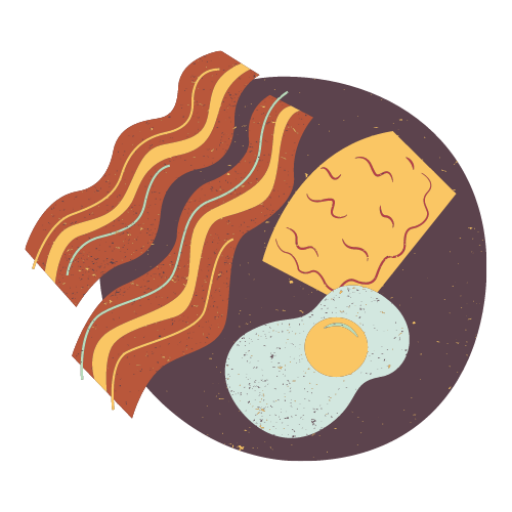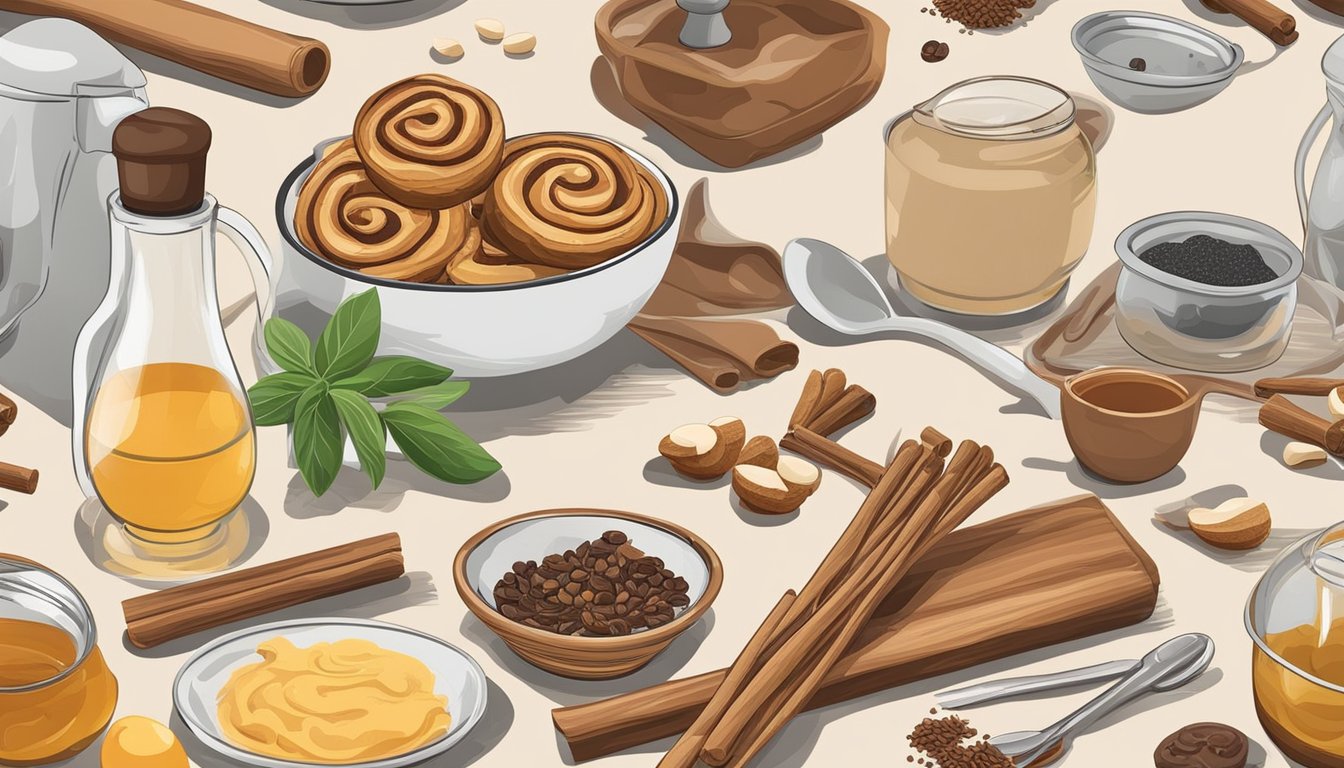Homemade cinnamon rolls are a delightful breakfast treat that fill the kitchen with an irresistible aroma. These soft, fluffy pastries feature a warm, gooey center swirled with cinnamon and brown sugar, topped with a rich cream cheese frosting. To make homemade cinnamon rolls, start by preparing a simple yeast dough, then spread it with butter, cinnamon, and sugar before rolling, slicing, and baking.
The process of creating cinnamon rolls from scratch allows for customization of flavors and textures. Bakers can adjust the amount of cinnamon, experiment with different types of frosting, or even add nuts or dried fruit to the filling. While cinnamon rolls require some time and effort, the result is a batch of freshly baked pastries that surpass store-bought versions in taste and satisfaction.
Cinnamon rolls make an excellent centerpiece for weekend brunches or special occasion breakfasts. Their indulgent nature and comforting flavors bring people together, creating memorable moments around the table. With a bit of practice, anyone can master the art of homemade cinnamon rolls and impress family and friends with this classic breakfast staple.
Understanding Cinnamon Rolls
Cinnamon rolls are a beloved breakfast treat enjoyed worldwide. These sweet, spiral pastries combine soft dough with a fragrant cinnamon-sugar filling and creamy frosting.
History and Popularity
Cinnamon rolls trace their origins to Sweden, where they’re known as “kanelbullar.” Introduced in the 1920s, these rolls quickly became a staple in Swedish cuisine.
The treat gained popularity in North America during the mid-20th century. Bakeries and cafes began offering larger, sweeter versions of the classic Swedish roll.
Today, cinnamon rolls are a global phenomenon. They’re enjoyed in various forms across cultures, from mall food courts to high-end bakeries.
Home bakers often make classic homemade cinnamon rolls for special occasions or weekend breakfasts. The aroma of freshly baked rolls has become synonymous with comfort and indulgence.
Nutrition Facts
A typical cinnamon roll contains approximately 300-400 calories. This can vary based on size and ingredients.
The main components include:
- Carbohydrates: 40-50g
- Fat: 15-20g
- Protein: 5-7g
Cinnamon rolls are high in sugar, with 20-30g per serving. They also contain small amounts of fiber, calcium, and iron.
While not a nutritional powerhouse, cinnamon itself offers potential health benefits. It may help regulate blood sugar and has anti-inflammatory properties.
Homemade versions allow for ingredient control. Whole wheat flour can increase fiber content. Reducing sugar or using alternatives can lower calorie count.
Ingredients Overview
Creating delicious homemade cinnamon rolls requires a careful selection of ingredients. The right combination of flour, yeast, fillings, and toppings is essential for achieving that perfect balance of flavor and texture.
Types of Flour and Yeast
All-purpose flour is the most common choice for cinnamon rolls, providing a tender crumb. Bread flour can be used for a chewier texture. For the yeast, active dry yeast and instant yeast are both suitable options.
Active dry yeast needs to be dissolved in warm liquid before use. Instant yeast can be mixed directly with dry ingredients. Red Star and Platinum are reputable yeast brands.
When baking with yeast, it’s crucial to use warm milk (around 110°F) to activate it properly. This ensures a good rise and fluffy texture in the final product.
Choosing Your Fillings and Toppings
The classic cinnamon roll filling consists of butter, cinnamon, and sugar. Softened butter is spread over the rolled-out dough, then sprinkled with a mixture of cinnamon and sugar.
Brown sugar is often preferred for its rich, caramel-like flavor. Dark brown sugar provides a deeper molasses taste, while light brown sugar offers a milder sweetness.
For toppings, cream cheese frosting is a popular choice. It’s made with cream cheese, butter, powdered sugar, and vanilla extract. Some recipes include a touch of salt to balance the sweetness.
Additional Ingredients
Whole milk adds richness to the dough. Eggs provide structure and help bind ingredients together. Granulated sugar sweetens the dough and aids in yeast fermentation.
Salt is crucial for enhancing flavors and controlling yeast activity. Vanilla extract adds depth to both the dough and frosting.
Some recipes call for heavy cream poured over the rolls before baking. This creates a gooey, caramel-like bottom layer.
Measuring ingredients accurately is key. Using a kitchen scale ensures consistency and the best results in your homemade cinnamon rolls.
Preparing the Dough
Creating the perfect cinnamon roll dough is a crucial step in achieving fluffy, delicious rolls. The process involves carefully combining ingredients, kneading to develop gluten, and allowing time for the dough to rise.
Mixing Dry and Wet Ingredients
Start by dissolving active dry yeast in warm milk (around 110°F). This activates the yeast and kickstarts fermentation. In a large bowl, combine flour, sugar, and salt.
Make a well in the center of the dry ingredients. Add the yeast mixture, melted butter, and beaten eggs. Gently mix to form a shaggy dough.
Gradually incorporate the remaining flour until a soft, slightly sticky dough forms. The dough should pull away from the sides of the bowl but still feel tacky to the touch.
Kneading and First Rise
Turn the dough onto a lightly floured surface. Knead for 8-10 minutes until smooth and elastic. This develops gluten, giving the rolls their signature texture.
To knead, push the dough away with the heel of your hand, fold it back over itself, give it a quarter turn, and repeat. The dough is ready when it springs back when lightly pressed.
Place the kneaded dough in a greased bowl, cover with a clean kitchen towel, and let rise in a warm spot for about 1 hour or until doubled in size.
Dough Rolling Techniques
After the first rise, punch down the dough to release air bubbles. Turn it onto a lightly floured surface and roll into a rectangle, roughly 18×12 inches.
Use a rolling pin to even out the thickness. Start from the center and roll outwards, applying gentle pressure. Rotate the dough occasionally to maintain an even shape.
For perfectly straight edges, use a pizza cutter or sharp knife to trim the sides. This ensures uniform rolls when sliced.
Brush the surface with melted butter, leaving a 1/2-inch border along one long edge. This border helps seal the roll when pinched closed.
Making the Filling
The filling is the heart of any great cinnamon roll, providing that irresistible sweet and spicy flavor. A well-made filling creates gooey, caramelized layers within the rolls.
Preparing Cinnamon Sugar Mixture
In a small bowl, combine brown sugar and ground cinnamon. Use about 1 cup of brown sugar for every 2-3 tablespoons of cinnamon. Mix thoroughly to ensure even distribution of flavors. Some bakers add a pinch of salt to enhance the sweetness.
For extra richness, incorporate 1-2 tablespoons of softened butter into the mixture. This creates a more paste-like consistency that’s easier to spread and helps the filling stick to the dough.
Spreading the Filling
Roll out the cinnamon roll dough into a rectangle, about 1/4 inch thick. Brush the surface with melted butter, leaving a small border around the edges. This helps the filling adhere and creates a gooey texture.
Sprinkle the cinnamon sugar mixture evenly over the buttered dough. Use your hands or the back of a spoon to gently press the filling into the dough. This ensures it stays in place when rolling.
For an extra decadent touch, dot small pieces of cold butter over the cinnamon sugar. As the rolls bake, this will melt and create pockets of buttery goodness throughout.
Shaping and Cutting the Rolls

Creating perfectly shaped and evenly cut cinnamon rolls requires attention to detail and proper technique. The process involves carefully rolling out the dough, adding the flavorful filling, and precisely cutting the rolls to ensure consistent size and appearance.
Creating the Perfect Roll
Roll out the dough on a lightly floured surface into a rectangle approximately 12 by 14 inches. Spread softened butter evenly over the dough, leaving a small border around the edges.
Mix sugar and cinnamon, then sprinkle the mixture over the butter. This combination creates the classic cinnamon roll flavor that makes these sweet rolls irresistible.
Starting from the long edge, tightly roll the dough into a log. Pinch the seam to seal it, ensuring the filling stays inside.
For extra indulgent rolls, consider adding chopped nuts or raisins to the filling before rolling.
Cutting Techniques
Use a sharp knife or unflavored dental floss to cut the log into individual rolls. Aim for 1-inch thick slices to create uniformly sized rolls.
If using a knife, gently score the log first to mark where you’ll cut. This helps maintain the round shape of each roll.
For the dental floss method, slide a long piece of floss under the log. Cross the ends over the top and pull to slice through the dough cleanly.
Arrange the cut rolls in a greased baking pan, leaving space between each for rising. For the best cinnamon rolls, let them rise until doubled in size before baking.
Baking and Icing
The final steps of preparing homemade cinnamon rolls involve baking them to golden perfection and topping them with a creamy icing. Proper baking temperature and timing are crucial for achieving the ideal texture.
Preheating and Baking
Preheat the oven to 375°F (190°C). Place the risen cinnamon rolls in a greased 9×13-inch baking dish. Bake for 18-22 minutes, until the rolls are lightly golden on top and no longer doughy in the center.
For even baking, rotate the dish halfway through the baking time. To test for doneness, gently tap the top of a roll – it should feel firm and sound hollow.
Let the rolls cool in the pan for 5-10 minutes before icing. This allows them to set slightly and prevents the icing from melting completely.
Applying Cream Cheese Icing
While the rolls cool, prepare the cream cheese icing. In a medium bowl, beat softened cream cheese until smooth. Add powdered sugar, vanilla extract, and a splash of milk or cream. Mix until creamy and spreadable.
Use a spatula to spread the icing evenly over the warm rolls. For a thicker layer, wait until the rolls have cooled completely before applying.
For a professional touch, drizzle additional icing in a zigzag pattern across the tops of the rolls. Serve the cinnamon rolls warm for the best taste and texture.
Storing and Reheating

Proper storage and reheating techniques ensure your homemade cinnamon rolls stay fresh and delicious. Careful handling preserves their taste and texture for later enjoyment.
Storing Leftovers
Store leftover cinnamon rolls in an airtight container at room temperature for 1-2 days. For longer storage, refrigerate for up to 1 week. Place parchment paper between layers to prevent sticking.
Freeze cinnamon rolls for up to 2 months. Wrap each roll individually in plastic wrap, then place in a freezer bag. Remove excess air before sealing.
For unfrosted rolls, freeze them before adding icing. This allows for fresher-tasting frosting when serving.
Label containers with the date to track freshness. Thaw frozen rolls overnight in the refrigerator before reheating.
Best Reheating Methods
Oven reheating produces the best results. Preheat to 350°F (175°C). Place rolls on a baking sheet and cover with foil. Heat for 10-15 minutes until warm.
For a quicker option, use the microwave. Place a roll on a microwave-safe plate. Cover with a damp paper towel. Heat for 20-30 seconds on medium power.
Air fryers offer another effective method. Set to 350°F (175°C). Heat rolls for 3-5 minutes, checking frequently to avoid overcooking.
Add a small pat of butter on top before reheating to enhance moisture and flavor. Drizzle with extra icing after warming for a fresh-baked taste.
Alternative Variations

Cinnamon rolls offer endless possibilities for customization. From time-saving methods to dietary accommodations and creative twists, there’s a version for every preference and occasion.
No-Yeast and Overnight Recipes
No-yeast cinnamon rolls are perfect for those short on time. These quick cinnamon rolls use baking powder or baking soda as leavening agents, resulting in a tender, biscuit-like texture. Buttermilk can be added for extra tang and moisture.
For busy mornings, overnight cinnamon rolls are a game-changer. Prepare the dough and assemble the rolls the night before, then refrigerate. In the morning, let them come to room temperature and bake for a stress-free breakfast.
Another time-saving option is using pre-made pizza dough as a base for cinnamon rolls. Simply roll out the dough, add the filling, and bake for a quick and easy treat.
Diet-Specific Adaptations
Gluten-free cinnamon rolls can be made using a blend of rice flour, tapioca starch, and xanthan gum. For a vegan version, replace butter with coconut oil and use plant-based milk.
Low-sugar alternatives incorporate natural sweeteners like mashed bananas or applesauce in the dough. The filling can be made with a sugar substitute or reduced-sugar fruit spread.
Whole grain cinnamon rolls offer a nutritious twist. Use whole wheat flour or a combination of whole wheat and all-purpose flour for added fiber and nutrients.
Inventive Cinnamon Roll Twists
Maple pecan sticky buns are a decadent variation. Top the rolls with a mixture of maple syrup, brown sugar, and chopped pecans before baking for a gooey, caramelized finish.
Savory cinnamon rolls make an unexpected snack or brunch item. Fill the dough with herbs, cheese, and ham or bacon for a unique flavor profile.
Fruit-filled cinnamon rolls add a burst of freshness. Try incorporating diced apples, blueberries, or strawberries into the filling for a fruity twist on the classic recipe.
Baking with Yeast Guide
Working with yeast can be tricky, but understanding common issues and solutions will help ensure successful cinnamon rolls. Proper temperature, activation time, and dough handling are key factors in achieving soft, fluffy results.
Common Challenges and Solutions
Yeast fails to activate: Ensure water temperature is between 100-110°F (38-43°C). Too hot kills yeast, too cold slows activation. Test yeast viability by proofing in warm water with sugar for 5-10 minutes. Bubbles indicate active yeast.
Dough doesn’t rise: Place dough in a warm, draft-free spot. Ideal temperature is 75-85°F (24-29°C). Cover with a damp cloth to prevent drying. Allow sufficient time – usually 1-2 hours for first rise.
Dense or heavy rolls: Don’t add too much flour. Dough should be slightly sticky. Knead thoroughly to develop gluten structure. Let dough rise fully before shaping and baking.
Overproofed dough: Watch rising time closely. Dough is ready when it doubles in size and springs back slowly when poked. Overproofed dough deflates easily and produces flat rolls.




